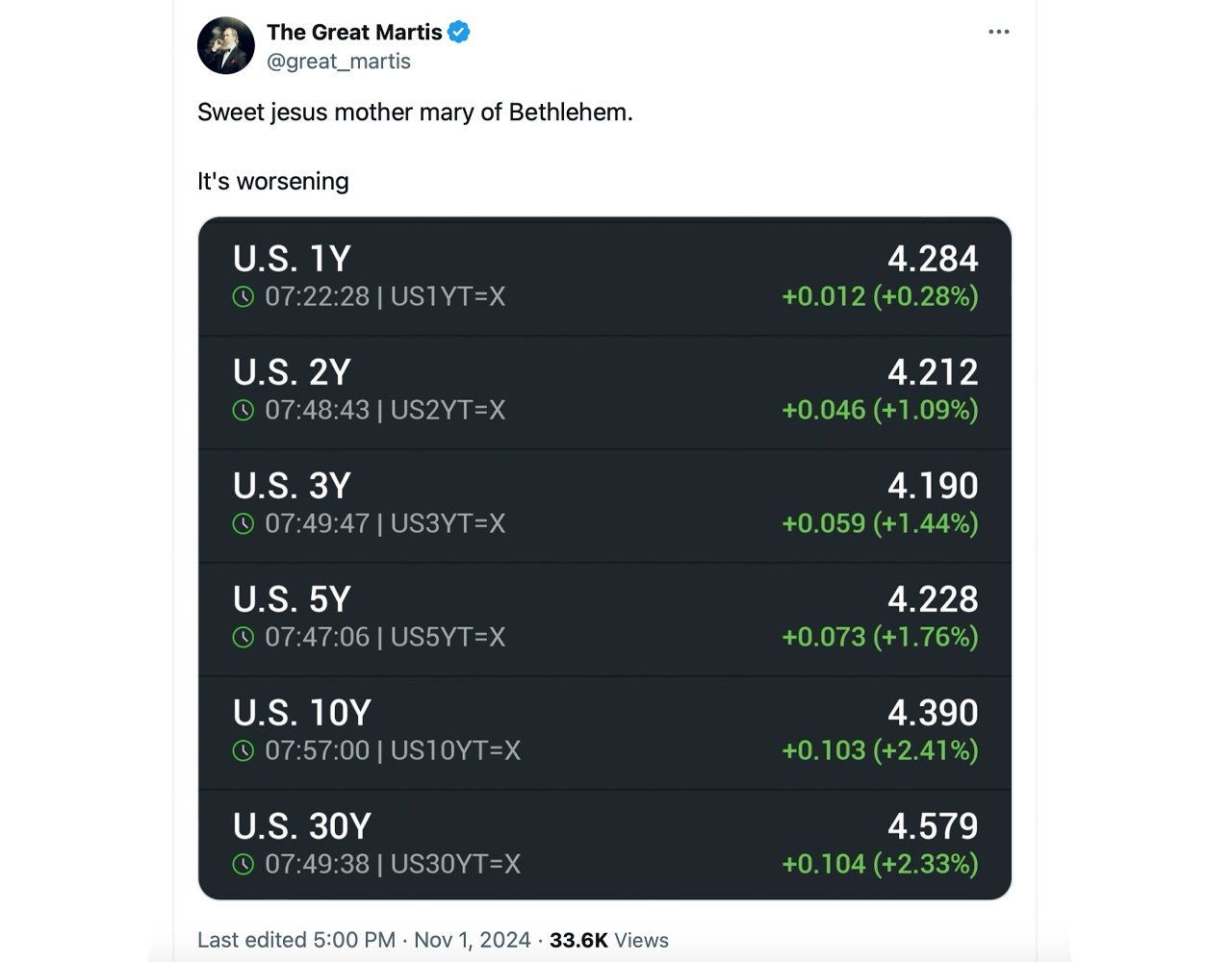As the U.S. approaches the 2024 election, economic indicators are signaling turbulence ahead, with the U.S. Treasury yield curve experiencing what analysts call a “bear steepening.” The election on Nov. 5, in which former President Donald Trump faces off against incumbent Vice President Kamala Harris, is quickly followed by a critical FOMC meeting. Investors, already on edge, are moving billions into perceived safe-haven assets like bonds, bitcoin (BTC), and gold as Treasury yields, particularly on long-term bonds, rise sharply.
Understanding the Yield Curve and Bear Steepening
The yield curve, a visual representation of yields on Treasury securities across various maturities, traditionally slopes upward, reflecting higher yields for longer maturities. However, for more than two years, the yield curve had been inverted—a situation in which short-term yields surpass long-term ones, historically a predictor of recession. In recent months, this inversion has reversed, leading to a steepening of the yield curve, which occurs when long-term yields rise faster than short-term ones. This steepening has been sharpest in the 10-year and 30-year Treasury bonds, whose yields are up 2.41% and 2.33%, respectively.

A bear steepening is an especially concerning form of steepening, marked by rising yields across the board but with longer-term bonds climbing more aggressively than short-term ones. This often reflects market expectations of higher inflation and possibly greater government borrowing—factors that push yields up on longer maturities. It’s a warning signal that market participants anticipate potential economic struggles, even a deep recession.
Historical Context and the Inversion’s Role in Recession
An inverted yield curve has preceded every major American recession, including the Great Depression. This period of inversion, paired with the subsequent steepening, often signals the economy’s transition from a recessionary warning to a potential economic downturn. In this case, the bear steepening in the yield curve aligns with rising inflation fears and market anxieties over a possible pivot by the Federal Reserve to rate cuts if the economy weakens further.
The recent steepening is compounded by risk aversion, a tendency for investors to seek safer assets during uncertain economic times. This shift can be seen in the ongoing surge in bond purchases as well as investments in bitcoin exchange-traded funds (ETFs). These trends underscore a growing desire among investors to secure value amid the current economic volatility.
Broader Implications: Mortgage Rates, Loans, and Economic Strain
The steepening of the yield curve has broader implications for U.S. consumers and businesses. Rising long-term yields can increase the cost of borrowing across the economy, affecting mortgage rates, car loans, and corporate financing. For homeowners, this can mean higher monthly payments or difficulty securing loans. For businesses, elevated borrowing costs could curb expansion efforts, restraining economic growth further.
The bear steepening also highlights market expectations of a potentially expansionary fiscal policy post-election, regardless of the outcome. A Trump victory might signal increased spending or tax cuts, adding pressure on government deficits and potentially fueling inflation. Likewise, a Harris-Walz administration may maintain a strong military budget for foreign wars and leverage regulation by enforcement, potentially adding to the nation’s problems. In either scenario, these fiscal approaches could perpetuate inflationary pressures, which, if not matched by economic growth, could deepen economic strain.
While many investors are hopeful that fiscal and monetary policy shifts may provide stability, the outlook for 2025 remains clouded. Should the economy enter a recession, the potential for economic hardship will challenge the next presidential administration regardless of its political orientation. With interest rates elevated, inflation still a threat, and fiscal policy likely to be stretched thin, the U.S. economy may be entering a period of prolonged difficulty, not unlike the economic distress seen during the Great Depression.
免责声明:本文章仅代表作者个人观点,不代表本平台的立场和观点。本文章仅供信息分享,不构成对任何人的任何投资建议。用户与作者之间的任何争议,与本平台无关。如网页中刊载的文章或图片涉及侵权,请提供相关的权利证明和身份证明发送邮件到support@aicoin.com,本平台相关工作人员将会进行核查。




